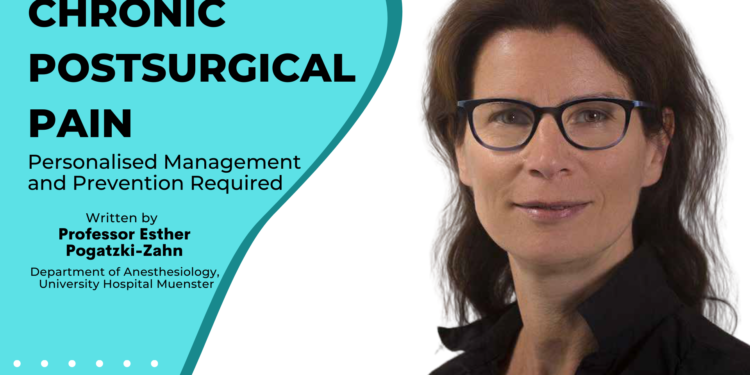Chronic Postsurgical pain – Personalised Management and Prevention Required
Written by Professor Esther Pogatzki-Zahn, Department of Anesthesiology, Intensive Care and Pain Medicine, University Hospital Muenster, Albert-Schweitzer-Campus 1, 48149 Münster, Germany
The next 2023 EFIC Congress – Pain in Europe XIII (https://efic-congress.org/) taking place on 20-23 September 2023 in Budapest, Hungary will showcase the most promising developments in the personalised management of various pain conditions. One such condition will be chronic postsurgical pain.
Background
Chronic pain (defined as pain that persists or recurs longer than 3 months) after surgery is frequent and may have a lasting impact on the functioning and quality of life of the affected person. Despite this, chronic postsurgical is underrecognized and, consequently, undertreated. A patient’s risk for developing chronic pain after surgery was underestimated in the past. Data now show an incidence, varying with the type of operation, from 5% to 85%. Disabling chronic postsurgical pain that negatively affects the patient’s quality of life is in the range of 2% to 15%.
Chronic postsurgical pain typically involves both nociceptive and neuropathic components. Neuropathic features occur in approximately 30% of patients, a prevalence that varies according to the type of operation (e.g., higher after thoracotomy or mastectomy, lower after hip or knee arthroplasty). Nerve lesion is an important although not the sole risk factor for neuropathic chronic postsurgical pain.
Chronic postsurgical pain is included in the current International Classification of Diseases, ICD-11 (Table 1).
Risk factors for chronic postsurgical pain
Ideally, assessing the risk for development of chronic pain in surgical patients and establishing predictive factors for the condition, would include preoperative and postoperative personalised assessment of psychological and neurophysiological factors, comprehensive intraoperative data on handling of tissue and nerves, and detailed early and late postoperative pain data. The assessment would ideally be good enough to exclude other causes of the chronic pain state. Some attempts were made to study predictive factors but data are inconclusive so far. Thus, personalised assessment is currently not possible.
EFIC 2023 will bring attention to the need for this type of assessment
Based on the current literature, we know that genetic susceptibility, presence of prior pain, prior opioid use, psychosocial factors, and one’s sex may increase one’s risk of developing chronic postsurgical pain.
Genetic susceptibility: Sensitivity to physiological nociceptive and clinical pain varies significantly between individuals. Animal studies indicate that the susceptibility to develop neuropathic pain has a strong heritable component, but the genes responsible have yet to be identified.
Presence of prior pain: Preceding pain is associated with the development of chronic postsurgical pain. For example, amputees with severe phantom limb pain have more often had intense and persistent preamputation pain than amputees with less intense phantom pain. A similar association is noted between the intensity of acute postoperative pain and subsequent development of chronic pain after breast surgery, thoracotomy, and inguinal hernia repair.
Prior opioid use: Preoperative (long-term) opioid intake has been associated with increased risk of developing disabling chronic pain post-surgery.
Psychosocial factors: Beliefs, expectation of pain, fear, past memories, social environment, work, and activity levels, all affect the pain experience. Preoperative anxiety is correlated with postoperative pain experience. Fear of pain in the postoperative setting and the avoidance of such pain might also have a negative effect on how pain is perceived and resolved.
Sex: Several studies show that women have higher postoperative pain than men.
With more risk factors, the risk increases. By estimating the risk of a patient, the strategy to prevent and treat pain can (and should) be adjusted. Thus, pain management after surgery should be personalized, related to specific risk factors of the patient.
Current treatments for postsurgical pain
All major international guidelines recommend a balanced, multimodal pain management. This involves a a combination of non-opioid analgesics (like non- steroidal anti-inflammatory drugs, metamizole or paracetamol) and – if required – opioids.
Opioids carry significant harms and so their use should follow certain rules:
– Opioids should be given orally, where possible
– Educate patient about benefits and harms of short- and long-term use
– After discharge, patients should be advised about correct use and maximum dosages should not be exceeded.
Also, alternative treatment options should be considered. Here, regional anesthesia techniques are of major importance and build a cornerstone of acute perioperative pain management. All management options should always balance between benefits and harms for each individual patient. Non-pharmacological pain management strategies and treatment options (for example cooling, relaxation, hypnosis, or music) have been shown to provide additional pain reduction after surgery and should be used.
EFIC 2023 will showcase the most up to date research on new treatments for postsurgical pain
Preventing chronic postsurgical pain
– Regional anaesthesia may reduce the risk of chronic postsurgical pain in some patients.
– Epidural analgesia may prevent chronic pain after thoracotomy in one patient out of four thus treated.
– Paravertebral block in breast cancer surgery may prevent chronic pain in one of five women.
– Ketamine infused perioperatively has produced some positive findings but not uniformly.
– Gabapentinoids overall, lack a significant clinical effect.
EFIC 2023 will have discussions about preventative treatments for chronic postsurgical pain.
PROSPECT initiative
To provide advise on which analgesic drug or techniques are of most benefit after specific surgical procedures, the PROSPECT (PROcedure-SPECific postoperative pain managemenT) initiative was formed. There are recommendations for several surgical procedures available including the evidence behind them. The recommendations are available on the prospect website (https://esraeurope.org/prospect/).
References available on request
Read the full magazine: September IPN
Read our Latest News








